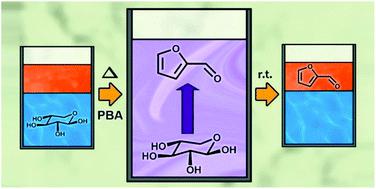当前位置:
X-MOL 学术
›
Green Chem.
›
论文详情
Our official English website, www.x-mol.net, welcomes your feedback! (Note: you will need to create a separate account there.)
Selectivity switch by phase switch – the key to a high-yield furfural process
Green Chemistry ( IF 9.8 ) Pub Date : 2021-09-06 , DOI: 10.1039/d1gc01752g Luca Ricciardi 1 , Willem Verboom 1 , Jean-Paul Lange 2, 3 , Jurriaan Huskens 1
Green Chemistry ( IF 9.8 ) Pub Date : 2021-09-06 , DOI: 10.1039/d1gc01752g Luca Ricciardi 1 , Willem Verboom 1 , Jean-Paul Lange 2, 3 , Jurriaan Huskens 1
Affiliation

|
We show the effective conversion of xylose into furfural, with a selectivity >90 mol%, in an aqueous–organic three-solvent system, which is composed of an apolar aromatic solvent, a polar organic solvent and acidic water and helps in catalyzing the formation of furfural. We couple this with a pre-extraction step of xylose as a boronic diester into a promising integrated process for valorising a diluted xylose hydrolysate. This process promises facile recovery of furfural and good recycling of all solvent components. The use of the boronic diester was found to be irrelevant for obtaining high selectivity, as its hydrolysis under the reaction conditions is fast. Surprisingly, the >90 mol% selectivity requires the three-solvent system to transition from biphasic to monophasic under the reaction conditions. Phenylboronic acid (PBA) used to extract xylose was found to be instrumental to this transition; PBA-lean media (<20 mM PBA) remain biphasic under the reaction conditions and deliver only 70 mol% selectivity. Water partial pressure measurements across the phase transition temperature confirm the occurrence of the phase transition. The increase of the apolar nature of the reaction medium when transitioning from biphasic to monophasic operation, reached upon mixing of the aromatic solvent with the water–polar organic phase, is likely responsible for the improved selectivity. The presence of an aromatic solvent in the mixture is important, probably due to its interaction with PBA that is instrumental to achieving the phase transition. A 1 : 1 : 1 toluene–sulfolane–water (pH = 1) mixture and [PBA] > 20 mM resulted in the highest observed xylose-to-furfural selectivity (95 mol%).
中文翻译:

逐相切换的选择性切换——高产糠醛工艺的关键
我们展示了在由非极性芳烃溶剂、极性有机溶剂和酸性水组成的水-有机三溶剂体系中,木糖有效转化为糠醛,选择性 >90 mol%,有助于催化形成糠醛。我们将其与木糖作为硼二酯的预提取步骤结合到一个有希望的整合过程中,以提高稀释的木糖水解物的价值。该过程保证了糠醛的轻松回收和所有溶剂组分的良好回收。发现使用硼二酯与获得高选择性无关,因为其在反应条件下的水解速度很快。令人惊讶的是,>90 mol% 的选择性需要三溶剂系统在反应条件下从双相转变为单相。发现用于提取木糖的苯硼酸 (PBA) 有助于这种转变;贫 PBA 培养基 (<20 mM PBA) 在反应条件下保持双相状态,并且仅提供 70 mol% 的选择性。跨越相变温度的水分压测量证实了相变的发生。当从双相操作转变为单相操作时,反应介质的非极性性质的增加,在芳香族溶剂与水极性有机相混合时达到,可能是提高选择性的原因。混合物中芳香族溶剂的存在很重要,可能是因为它与 PBA 相互作用,有助于实现相变。A 1 : 1 : 1 甲苯-环丁砜-水 (pH = 1) 混合物和 [PBA] >
更新日期:2021-09-24
中文翻译:

逐相切换的选择性切换——高产糠醛工艺的关键
我们展示了在由非极性芳烃溶剂、极性有机溶剂和酸性水组成的水-有机三溶剂体系中,木糖有效转化为糠醛,选择性 >90 mol%,有助于催化形成糠醛。我们将其与木糖作为硼二酯的预提取步骤结合到一个有希望的整合过程中,以提高稀释的木糖水解物的价值。该过程保证了糠醛的轻松回收和所有溶剂组分的良好回收。发现使用硼二酯与获得高选择性无关,因为其在反应条件下的水解速度很快。令人惊讶的是,>90 mol% 的选择性需要三溶剂系统在反应条件下从双相转变为单相。发现用于提取木糖的苯硼酸 (PBA) 有助于这种转变;贫 PBA 培养基 (<20 mM PBA) 在反应条件下保持双相状态,并且仅提供 70 mol% 的选择性。跨越相变温度的水分压测量证实了相变的发生。当从双相操作转变为单相操作时,反应介质的非极性性质的增加,在芳香族溶剂与水极性有机相混合时达到,可能是提高选择性的原因。混合物中芳香族溶剂的存在很重要,可能是因为它与 PBA 相互作用,有助于实现相变。A 1 : 1 : 1 甲苯-环丁砜-水 (pH = 1) 混合物和 [PBA] >


























 京公网安备 11010802027423号
京公网安备 11010802027423号